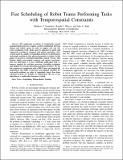| dc.contributor.author | Gombolay, Matthew C. | |
| dc.contributor.author | Wilcox, Ronald James | |
| dc.contributor.author | Shah, Julie A | |
| dc.date.accessioned | 2018-04-10T17:16:27Z | |
| dc.date.available | 2018-04-10T17:16:27Z | |
| dc.date.issued | 2018-02 | |
| dc.date.submitted | 2018-02 | |
| dc.identifier.issn | 1552-3098 | |
| dc.identifier.issn | 1941-0468 | |
| dc.identifier.uri | http://hdl.handle.net/1721.1/114651 | |
| dc.description.abstract | The application of robotics to traditionally manual manufacturing processes requires careful coordination between human and robotic agents in order to support safe and efficient coordinated work. Tasks must be allocated to agents and sequenced according to temporal and spatial constraints. Also, systems must be capable of responding on-the-fly to disturbances and people working in close physical proximity to robots. In this paper, we present a centralized algorithm, named 'Tercio,' that handles tightly intercoupled temporal and spatial constraints. Our key innovation is a fast, satisficing multi-agent task sequencer inspired by real-time processor scheduling techniques and adapted to leverage a hierarchical problem structure. We use this sequencer in conjunction with a mixed-integer linear program solver and empirically demonstrate the ability to generate near-optimal schedules for real-world problems an order of magnitude larger than those reported in prior art. Finally, we demonstrate the use of our algorithm in a multirobot hardware testbed. | en_US |
| dc.publisher | Institute of Electrical and Electronics Engineers (IEEE) | en_US |
| dc.relation.isversionof | http://dx.doi.org/10.1109/TRO.2018.2795034 | en_US |
| dc.rights | Creative Commons Attribution-Noncommercial-Share Alike | en_US |
| dc.rights.uri | http://creativecommons.org/licenses/by-nc-sa/4.0/ | en_US |
| dc.source | MIT Web Domain | en_US |
| dc.title | Fast Scheduling of Robot Teams Performing Tasks With Temporospatial Constraints | en_US |
| dc.type | Article | en_US |
| dc.identifier.citation | Gombolay, Matthew C. et al. “Fast Scheduling of Robot Teams Performing Tasks With Temporospatial Constraints.” IEEE Transactions on Robotics 34, 1 (February 2018): 220–239 © 2018 IEEE | en_US |
| dc.contributor.department | Lincoln Laboratory | en_US |
| dc.contributor.department | Massachusetts Institute of Technology. Department of Mechanical Engineering | en_US |
| dc.contributor.mitauthor | Gombolay, Matthew C. | |
| dc.contributor.mitauthor | Wilcox, Ronald James | |
| dc.contributor.mitauthor | Shah, Julie A | |
| dc.relation.journal | IEEE Transactions on Robotics | en_US |
| dc.eprint.version | Author's final manuscript | en_US |
| dc.type.uri | http://purl.org/eprint/type/JournalArticle | en_US |
| eprint.status | http://purl.org/eprint/status/PeerReviewed | en_US |
| dc.date.updated | 2018-04-10T15:55:48Z | |
| dspace.orderedauthors | Gombolay, Matthew C.; Wilcox, Ronald J.; Shah, Julie A. | en_US |
| dspace.embargo.terms | N | en_US |
| dc.identifier.orcid | https://orcid.org/0000-0002-5321-6038 | |
| dc.identifier.orcid | https://orcid.org/0000-0003-1338-8107 | |
| mit.license | OPEN_ACCESS_POLICY | en_US |
